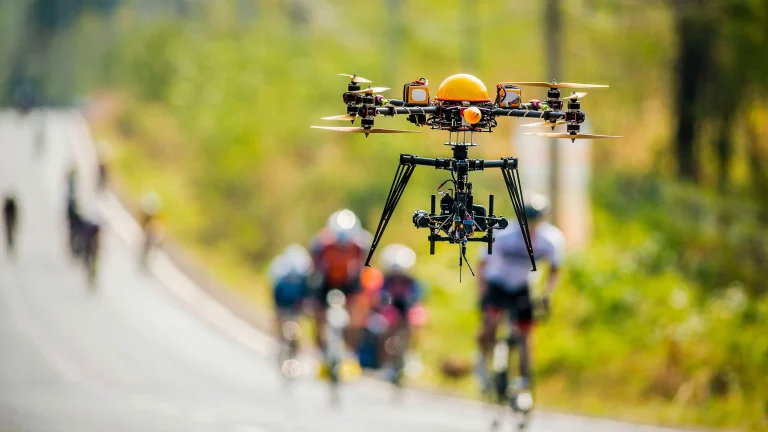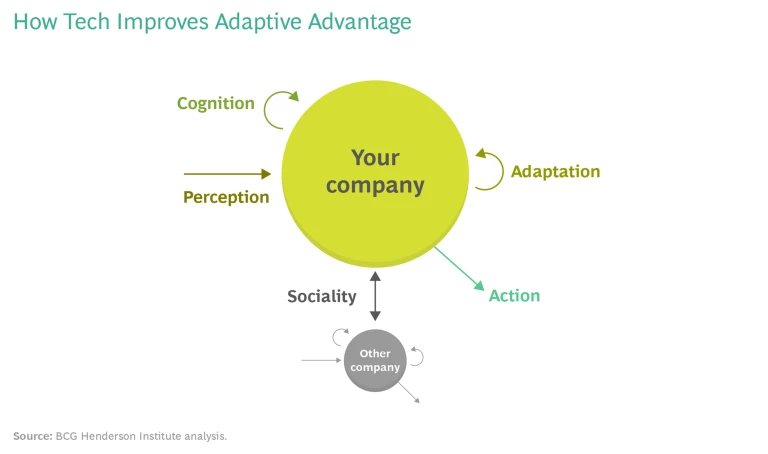Companies are investing in technology initiatives to invent new business models and drive efficiencies in their business. There is no doubt that technology has enabled the creation of the world’s most valuable companies. At the end of 2020, seven out of the top ten most highly valued companies were B2C digital platforms and 25% of the S&P value was from GAFAM (Google, Apple, Facebook, Amazon, and Microsoft). These companies have created vibrant mobile and cloud-based technology platform businesses and rely heavily on data that consumers create and give away for free to enable advertising, search, and e-commerce.
While much of the focus to date has been on B2C, momentum in B2B is building. Industry-specific opportunities are emerging to capture new value from connectivity, data, and analytics. For our recent Fortune Future 50 list, BCG and Fortune examined more than a thousand companies to identify some of the world’s most vital companies, those with the greatest capacity to continually reinvent their businesses and sustain long-term growth. In the results, seven of the top ten are enterprise SaaS companies (among them ServiceNow, Workday, Atlassian, and Splunk) that help businesses with their digital aspirations, providing platforms to digitize workflows, analyze data, enable e-commerce, or build new software offers. This suggests that companies are accelerating their investments in the digitization of their products and workflows.
Although necessary, technology alone is not sufficient for value creation. Leading companies need to demonstrate adaptive advantage and continuously evolve their business model. At the most fundamental level, how do vital companies build adaptive advantage?
Building Adaptive Advantage Through Technology
In biological ecosystems that are subject to highly dynamic environments, successful organisms are those capable of adaptation. Rapid adaptation requires organisms to see more, think faster, and react socially in the context of their surroundings.
Similarly, in today’s business environment, we find that value pools are changing rapidly. The BCG Henderson Institute analyzed five industry verticals (industrial automation, precision agriculture, transportation and logistics, building automation, and automotive) and found that a quarter of the highest-value problems require collective action across enterprises to solve. Looking more broadly, we reviewed smart city use cases such as traffic optimization, disaster response, and energy management—again, half of current use cases and as much as 85% of future use cases require cross-industry data sharing and collaboration. At a broader level, nearly all of the UN sustainable development goals require collaboration that spans organizational and geographic boundaries.
Identifying promising opportunities and delivering new services require a much broader set of partnerships than historical linear value chains. In today’s dynamic environment, companies need to expand their perception, enhance their cognition, and extend their sociality. (See the exhibit.)
Expand perception. By using technology to expand their perception capability, companies are broadening their “umwelt,” or subjective worldview. Companies are doing this by integrating new data from external and novel sources like IoT sensors and business ecosystem partners to build a more complete, fresher, clearer, deeper, and newer picture of the world to test untried hypotheses and correlations.
For example, financial firms and asset managers are using novel, alternative data sources like satellite imagery and logistics data to gain an edge in forecasting financial performance. They are extending their ability to sense. They are able to identify changing conditions sooner than their competition, identify “weak signals” through new data sources, and see the unseen. In a specific instance, a large global investor was able to use geolocation and credit card data to identify share loss from one retailer to another before this information was public.
Enhance cognition. However, successful companies don’t just stop at expanding their perception. They enhance their cognition by transforming this data into insights and actions. Aggregating and integrating these new data sources enable hypothesis testing, correlation analysis, and machine learning to surface new relationships, identify causality, and test potential actions.
For example, the agriculture industry is experiencing a tech revolution, with farming increasingly transitioning from an art to a data-driven science, powered by AI. Data from satellites, field sensors, drones, and farming equipment are increasingly aggregated and analyzed to inform decisions related to equipment workflow and farm management, thereby improving yield and reducing input costs. Farmers are better able to optimize factors such as pesticide application, irrigation, and timing of seeding and harvests.
Similarly, cities are building platforms to aggregate data across public and private sources to improve the citizen experience. They identify patterns in the data to assess the effectiveness of specific policies. For example, combining real-time air quality data and traffic pattern information can help cities implement dynamic tolling programs that improve air quality. Aggregating data from mobility service providers like Uber and Waze enables cities to improve urban planning decisions and take action to improve transportation services, health, and other quality-of-life metrics.
Extend sociality. Finally, companies build adaptive advantage by extending their sociality—the tendency of groups to develop social links and live in communities, thereby influencing the worldview and actions of others.
Sociality enables co-creation of new services—for example, by companies participating in business ecosystems, sharing data, and leveraging innovation platforms. Extending an antenna to capture and broadcast new data sources can enhance an organization’s perception and augment the worldview of others and influence their actions. Understanding how other companies use data can reveal new opportunities and potential for collaboration.
For example, the plastics and packaging industry is increasingly focused on circularity to increase plastic reuse. The industry is seeking to foster collective action through transparency and accountability in the plastics supply chain. Investors focused on sustainable business practices can use this transparency to make investment decisions. Competitive pressure created through transparency will drive companies to launch initiatives to increase circularity.
Sociality enables collective action, unlocks customer value, and generates new revenue sources. The collective action does not always take the form of collaboration; sociality also includes coopetition and changing the field of competition by sharing data to expand the worldview of ecosystem participants.
Achieving Adaptive Advantage Is Hard
Technology-enabled adaptive advantage in B2B businesses requires different levels of perception, cognition, and sociality to drive long-term value. To achieve a higher level of perception and cognition, data must be shared, transformed, and analyzed to uncover new insights. Insights alone are not sufficient; capturing value takes both individual and collective action.
However, data sharing across organizations is challenging.
First, data can be copied or shared indefinitely at zero cost, travel long distances, and be used in unintended ways, potentially putting at risk the company that is the source. Companies fear that sharing data with partners or participating in ecosystems will lead to a loss of competitive advantage, unintended disclosure to competitors, or brand risk through privacy violations.
Second, increasing perception from B2B data is more difficult than in B2C businesses. Unlike the consumer data collected from mobile devices, web browsing, and search, the data generated from connected enterprises and equipment is diverse, requires investment (for example, to augment equipment with sensors and stream data), is context-specific and hard to interpret without a deep understanding of the problem that needs to be solved, and is often proprietary. B2B data is more heterogenous and leads to friction and cost associated with “data wrangling” to get it into a usable form.
Third, expanding perception through data aggregation alone is not sufficient. The data must be creatively analyzed to reveal new relationships. Companies need to build talent pools of data scientists and engineers to deliver insights and expand cognition.
Finally, extending sociality requires coopetition and collaboration, often achieved through ecosystems and platforms that enable the delivery of new products and services in loosely coupled, symbiotic relationships. Building a technology platform is not enough; vibrant ecosystems encourage adoption (for network effects) to enable innovation, coopetition, and value sharing. However, building ecosystems can be fraught, requiring high investment and carrying high risks of failure. BCG Henderson Institute research found that 85% of business ecosystems fail.
Given these challenges, what actions should companies take to increase their adaptive advantage?
How Do Companies Capitalize?
Below are eight tangible steps companies take to build sustainable adaptive advantage by increasing perception, cognition, and sociality.
1. They identify gaps in their worldview. Organizations focus on the pressing questions that they or their customers need to answer. Where are critical gaps in their existing worldview? What new actions can they take if these gaps are filled? Answering these questions first can help identify and prioritize areas where data sharing could benefit their organization or products. In a second step, they think of new types and sources of data that could help build up their worldview.
2. They establish processes to creatively find or create new sources of data to complement their own. (See “How Far Can Your Data Go?”) Organizations seek out opportunities to contribute their data to various ecosystems, and they imagine the new use cases and business opportunities enabled by aggregation of their own data with third-party data. They continuously scan for new data sources.
3. They invest in tools and capabilities to deliver new insights. Companies invest in data and analytics capabilities while encouraging imagination to identify new hypotheses. Some companies adopt a data-driven approach to innovation and experimentation to accelerate learning. Some even apply unsupervised learning to identify previously undetected patterns.
4. They think beyond themselves as the unit of analysis. (See “How IoT Data Ecosystems Will Transform B2B Competition.”) They collaborate with partners that can augment their own capabilities. Companies that aggregate data also participate in innovation platforms and leverage data science competitions to tap into new sources of talent and expand their imagination.
5. They share their data to expand the worldview of others. They reflect on what types of problems their data can help solve. Traffic data can gauge policy effectiveness, thermometer data can help direct public health efforts, and 140 characters can track national moods.
6. They embrace ecosystem participation and leverage platforms to create new products and services and extend their reach. (See “Orchestrating the Value in IoT Platform-Based Business Models.”)
7. They employ governance and technology solutions to manage the tradeoff between innovation and risk. Technology solutions include data directories, sample data sets, synthetic data, and distributed data models that allow access but prevent data from being replicated.
8. They translate their enhanced perception, cognition, and sociality into action. They build structures that allow them to see and absorb the unexpected. They expand their decision capacity to transcend the limitations of the human mind, in both scope and agility. Only with this last step can they convert their newfound capability into value.
Digital and data are growing and propagating. However, realizing the digital promise and gaining a sustainable, adaptive advantage take much more than investments in technology. To unlock significant new value, companies need to expand their perception beyond their industry boundaries to surface hidden relationships. They must enhance their cognition and imagine the art of the possible for new opportunities. By participating in ecosystems and other technologically enabled business models, they can extend their sociality and collectively build new sources of growth. Technology alone is not sufficient, but it is a critical enabler of the perception, cognition, and sociality required to achieve adaptive advantage.







